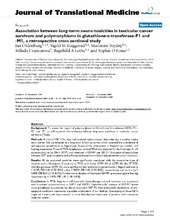Association between long-term neuro-toxicities in testicular cancer survivors and polymorphisms in glutathione-s-transferase-P1 and -M1, a retrospective cross sectional study
Oldenburg, Jan; Kraggerud, Sigrid M.; Brydøy, Marianne; Cvancarova, Milada; Lothe, Ragnhild A.; Fossa, Sophie D.
Peer reviewed, Journal article
Permanent lenke
https://hdl.handle.net/1956/2683Utgivelsesdato
2007-12-27Metadata
Vis full innførselSamlinger
Originalversjon
https://doi.org/10.1186/1479-5876-5-70Sammendrag
Background: To assess the impact of polymorphisms in Glutathione S-transferase (GST) -P1, - M1, and -T1 on self-reported chemotherapy-induced long-term toxicities in testicular cancer survivors (TCSs). Methods: A total of 238 TCSs, who had received cisplatin-based chemotherapy at median twelve years earlier, had participated in a long-term follow-up survey which assessed the prevalence of self-reported paresthesias in fingers/toes, Raynaud-like phenomena in fingers/toes, tinnitus, and hearing impairment. From all TCSs lymphocyte-derived DNA was analyzed for the functional A→G polymorphism at bp 304 in GSTP1, and deletions in GST-M1 and GST-T1. Evaluation of associations between GST polymorphisms and self-reported toxicities included adjustment for prior treatment. Results: All six evaluated toxicities were significantly associated with the cumulative dose of cisplatin and/or bleomycin. Compared to TCSs with either GSTP1-AG or GSTP1-AA, the 37 TCSs with the genotype GSTP1-GG, were significantly less bothered by paresthesias in fingers and toes (p = 0.039, OR 0.46 [0.22–0.96] and p = 0.023, OR 0.42 [0.20–0.88], respectively), and tinnitus (p = 0.008, OR 0.33 [0.14–0.74]). Furthermore, absence of functional GSTM1 protected against hearing impairment (p = 0.025, OR 1.81 [1.08–3.03]). Conclusion: In TCSs long-term self-reported chemotherapy-induced toxicities are associated with functional polymorphisms in GSTP1 and GSTM1. Hypothetically, absence of GST-M1 leaves more glutathione as substrate for the co-expressed GST-P1. Also intracellular inactivation of proapoptotic mediators represents a possible explanation of our findings. Genotyping of these GSTs might be a welcomed step towards a more individualized treatment of patients with metastatic testicular cancer.
